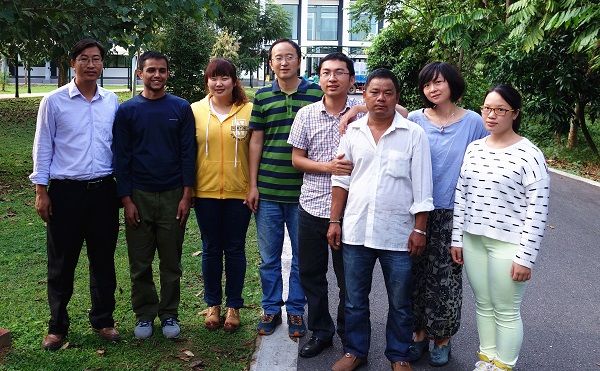
Head of the Group: Dr. FAN Zexin
E-mail: fanzexin@xtbg.org.cn
Website: http://trec.groups.xtbg.ac.cn/english-3/
Introduction
Tree Ring and Environmental Change Group, set up since June 2012, is a Young Scientist Group of Xishuangbanna Tropical Botanical Garden (XTBG), Chinese Academy of Sciences (CAS). This group focuses on environmental change in the tropical, subtropical regions of southwestern China. By combining dendrochronology, tree ecophysiology, and climatic statistics, we focus on reconstructing regional climate change during the past centuries; investigating growth-climate responses of tropical/sub-tropical tree species; detecting physiological adaptation of tropical plants to simulated environmental change (i.e. CO2 enrichment, global warming); modelling vegetation thermal response based on thermodynamics, energy balance and radiation balance.
Research topics
Tropical dendroecology and dendroclimatology
By using dendrochronology methods, we attempt to reconstruct regional climatic change of tropical Asia during the past centuries, study growth responses of tropical and subtropical tree species to climatic and environmental changes, as well as the physiological adaptation of tree growth to climate conditions.
Plant thermal response and their ecological significance
Based on thermodynamics, energy balance and radiation balance, we aim to reveal the relationship between vegetation thermal response and vegetation development and health on the scale of community and landscape, establish a thermodynamic index system to quantitatively evaluate ecosystem function.
Ecophysiological responses of tropical plants to simulated environmental changes
Taking advantages of plant ecophysiological techniques, we study photosynthesis, water relations and phenology of functional groups in tropical forests, as well as their physiological responses to simulated environmental changes (i.e. CO2 enrichments, warming experiments).
People

Ph.D in Geography, Associate Professor
Research interests: Climate change, Dendroecology, Dendroclimatology, Plant functional traits
E-mail: fanzexin@xtbg.org.cn

Ph.D in Ecology, Associate Professor
Research interests: Thermodynamic ecology, Ecosystem development, Ecosystem- climate interactions, Biodiversity distribution mechanism
E-mail: lh@xtbg.ac.cn

Ph.D in Ecology, Assistant Professor
Research interests: Plant eco-physiology, Functional traits
E-mail: fpl@xtbg.org.cn
Projects
[1] National Science Foundation of China, “Tree cambial activities and their responses to seasonal droughts in the tropical seasonal rainforest”, 220,000 RMB, 2011-2013.
[2] National Science Foundation of China, “Leaf temperature adjustment mechanism in hot dry and wet day regions”, 230,000 RMB, 2012-2015.
[2] West light project of Chinese Academy of Sciences, “Tree growth rates and forest productivity in relation to regional climatic change in Ailao subtropical Mountains, Southwest China”, 100,000 RMB, 2011-2013.
[3] Member Foundation of Youth Innovation Promotion Association, the Chinese Academy of Sciences, 400,000 RMB, 2011-2014.
[4] The Scientific Research Foundation for Returned Overseas Chinese Scholars, State Education Ministry, “Evolution and adaption of stem functional traits of tropical seasonal rainforests”, 38,000 RMB, 2011-2014.
[5] Foundation of Yong Scientist Group of Xishuangbanna Tropical Botanical Garden, CAS, 1000,000 RMB, 2012-2015.
[6] National Science Foundation of China, “Tree radial growth responses to climate change and rising atmospheric CO2 in the northern edge tropical rainforests”, 800,000 RMB, 2014-2017.
[7] National Science Foundation of China, “The effect of leaf and stem water uptake in the process of recover of the resurrection plants – A case study of Paraboea rufescens“, 230,000 RMB, 2014-2016.
Publications
PAGES 2k Consortium. 2013. Continental-scale temperature variability during the last two millennia. Nature Geoscience 6: 339-346. DOI: 10.1038/ngeo1797.
Feng-Mei Yang, Neiang Wang, Feng Shi, Fredrik Charpentier Ljungqvist, Shi-Gong Wang,Ze-Xin Fan, Jun-Wei Lu. 2013. Multi-proxy temperature reconstruction from the west Qingling Mountains, China, for the past 500 years. PLoS ONE 8(2): e57638. DOI: 10.137/journal.pone.0057638.
Shi-Bao Zhang, Kun-Fang Cao, Ze-Xin Fan, Jiao-Lin Zhang. 2012. Potential hydraulic efficiency in angiosperm trees increases with growth-site temperature but has no trade-off with mechanical strength. Global Ecology and Biogeography DOI: 10.1111/geb.12056.
Hua LIN, Xuli FAN, Xiang ZHOU and Jiangyun GAO. Self-interference is reduced in a secondary pollen presentation species, Duperrea pavettifolia (Rubiaceae). Flora, 2012, 207: 895-902.
Hua LIN, Jiangyun GAO, Zhirong ZHANG, Xuli FAN. Microsatellite markers for Duperrea pavettifolia (Rubiaceae). American Journal of Botany, 2012, 99: e310-e312.
Ze-Xin Fan, Axel Thomas. 2012. Spatiotemporal variability of reference evapotranspiration and its contributing climatic factors in Yunnan Province, SW China, 1961-2004. Climatic Change DOI: 10.1007/s10584-012-0479-4. (PDF link)
Pei-Li Fu, Yan-Juan Jiang, Ai-Ying Wang, Tim J. Brodribb, Jiao-Lin Zhang, Shi-Dan Zhu & Kun-Fang Cao. 2012. Stem hydraulic traits and leaf water-stress tolerance are coordinated with the leaf phenology of angiosperm trees in an Asian tropical dry karst forest. Annals of Botany DOI: 10.1093/aob/mcs092. (PDF link)
Ze-Xin Fan, Shi-Bao Zhang, Guang-You Hao, J.W. Ferry Slik, Kun-Fang Cao. 2012. Hydraulic conductivity traits predict growth rates and adult stature of 40 Asian tropical tree species. Journal of Ecology 100: 732-741. (PDF link)
Qin-Hua Tian, Xiu-Ji Zhou, Xiao-Hua Gou, Ping Zhao, Ze-Xin Fan, Samuli Helama. 2012. Analysis of reconstructed annual precipitation from tree-ring for the past 500 years in the middle Qilian Mountain. Science China Earth Sciences DOI: 10.1007/s11430-012-4375-6.
Ze-Xin Fan, Achim Bräuning, Axel Thomas, Jin-Bao Li, Kun-Fang Cao. 2011. Spatial and temporal temperature trends on the Yunnan Plateau (Southwest China) during 1961−2004.International Journal of Climatology 31: 2078-2090. (PDF link)
Ze-Xin Fan, Achim Bräuning, Qin-Hua Tian, Bao Yang, Kun-Fang Cao. 2010. Tree ring recorded May-August temperature variations since A.D. 1585 in the Gaoligong Mountains, southeastern Tibetan Plateau. Palaeogeography, Palaeoclimatology, Palaeoecology296: 94-102. (PDF link)
Hua LIN, Min CAO*, Yi-Ping ZHANG. 2010. Self-organization of tropical seasonal rain forest in southwest China. Ecological Modelling 222: 2812-2816. (PDF link)
Bao Yang, Qin Chun, Kai Huang, Ze-Xin Fan, Jing-Jing Liu. 2010. Spatial and temporal patterns of variations in tree growth over the northeastern Tibetan Plateau during the period 1450−2006. The Holocene 20(8): 1235-1245.
Ze-Xin Fan, Achim Bräuning, Bao Yang, Kun-Fang Cao. 2009. Tree ring density-based summer temperature reconstruction for the central Hengduan Mountains in southern China.Global and Planetary Change 65: 1-11. (PDF link)
Ze-Xin Fan, Achim Bräuning, Kun-Fang Cao, Shi-Dan Zhu. 2009. Growth-climate responses of high-elevation conifers in the central Hengduan Mountains in southern China.Forest Ecology and Management 258(3): 306-313. (PDF link)
Hua LIN, Min CAO*, Stoy C Paul, Yi-Ping ZHANG. 2009. Assessing self-organization of plant communities – A thermodynamic approach. Ecological Modelling 220: 784-790. (PDF link)
Ze-Xin Fan, Kun-Fang Cao, Peter Becker. 2009. Axial and radial variations in xylem anatomy of angiosperm and conifer trees in Yunnan, China. IAWA Journal 30(1): 1−13. (PDF link)
Qin-Hua Tian, Xiao-Hua Gou, Yong Zhang, Yong-Sheng Wang, Ze-Xin Fan. 2009. May-June mean temperature reconstruction over the past 300 years based on tree rings in the Qilian Mountains of the northeastern Tibetan Plateau. IAWA Journals 30(4): 421−434.
Ze-Xin Fan, Achim Bräuning, Kun-Fang Cao. 2008. Tree-ring based drought reconstruction in the central Hengduan Mountains (China) since A.D. 1655. International Journal of Climatology 28: 1879−1887. (PDF link)
Ze-Xin Fan, Achim Bräuning, Kun-Fang, Cao. 2008. Annual temperature reconstruction from the central Hengduan Mountains, as deduced from tree rings. Dendrochronologia. 26: 97−107. (PDF link)
Hua LIN, Min CAO*. 2008. Plant energy storage strategy and caloric value. Ecological Modelling 217: 132-138. (PDF link)
Hua LIN, Min CAO*, Jianhou ZHANG. 2007. Calorific values and energy allocation of a tropical seasonal rain forest and a montane evergreen broad-leaved forest in southwest China.Journal of plant ecology 31: 1103-1110.
Xiu Juan QIAO, Min CAO*, Hua LIN. 2007. Caloric values allocation of dominant species in four secondary forest at different ages in Xishuangbanna, Southwest China. Acta Phytoecologica Sinica 2: 326-332.
Hua LIN, Min CAO*. 2006. A preliminary study of thermodynamic processes in the development of forest ecosystems and plant populations. Acta Ecological Sinica 26: 4250-4256.
Z.Q. CAI, M. SLOT, Z.X. FAN. 2005. Leaf development and photosynthetic properties of three tropical tree species with delayed greening. Photosynthetica 43(1): 91−98.
Contacts
Address: Xishuangbanna Tropical Botanical Garden, Chinese Academy of Sciences
Menglun Town, Mengla County, Yunnan Province 666303, P.R. China
Tel.: +86-691-8713227; Fax: +86-691-8715070
Email: fanzexin@xtbg.org.cn
Website: http://trec.groups.xtbg.ac.cn/




